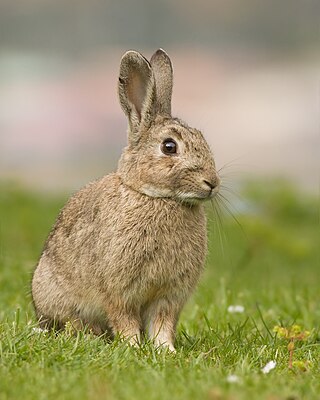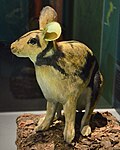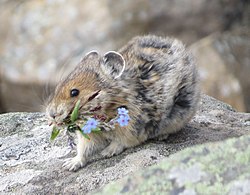List of lagomorphs
Animals in mammal order Lagomorpha From Wikipedia, the free encyclopedia
Lagomorpha is an order of placental mammals, comprising the rabbits, hares, and pikas. Members of this order are called lagomorphs. It currently comprises 93 extant species, which are grouped into 12 genera. Lagomorphs live on every major landmass except Antarctica, and in a variety of habitats, especially forests, grasslands, shrublands, and rocky areas. They are generally small in size and come in two main groupings of body plans, the larger rabbit group and smaller pika group, ranging overall from the 11 cm (4 in) long Gansu pika to the 76 cm (30 in) long desert hare. The domestic rabbit subspecies of the European rabbit has been domesticated, resulting in a worldwide distribution.


Lagomorpha is divided into two families: Leporidae, comprising the rabbits and hares; and Ochotonidae, or the pikas. The 64 extant species of Leporidae are divided into 11 genera, though the majority of the species are placed into Sylvilagus (cottontail rabbits) and Lepus (hares); the 29 extant species of Ochotonidae are grouped into a single genus, Ochotona. The exact organization of the species is not fixed, with many recent proposals made based on molecular phylogenetic analysis. No lagomorph species have recently gone extinct, though some species are endangered and the riverine rabbit is critically endangered.
Conventions
Range maps are provided wherever possible; if a range map is not available, a description of the collective range of species in that genera is provided. Ranges are based on the International Union for Conservation of Nature (IUCN) Red List of Threatened Species unless otherwise noted. All extinct genera or species listed alongside extant species went extinct after 1500 CE, and are indicated by a dagger symbol "†".
Classification
Summarize
Perspective

The order Lagomorpha consists of 93 extant species belonging to 12 genera. This does not include hybrid species or extinct prehistoric species. Modern molecular studies indicate that the 12 genera can be grouped into 2 families.[1]
Family Leporidae
- Genus Brachylagus (pygmy rabbit): one species
- Genus Bunolagus (riverine rabbit): one species
- Genus Caprolagus (hispid hare): one species
- Genus Lepus (hares): 32 species
- Genus Nesolagus (striped rabbits): two species
- Genus Oryctolagus (European rabbit): one species
- Genus Pentalagus (Amami rabbit): one species
- Genus Poelagus (Bunyoro rabbit): one species
- Genus Pronolagus (red rock hares): four species
- Genus Romerolagus (volcano rabbit): one species
- Genus Sylvilagus (cottontail rabbits): 19 species
Family Ochotonidae
- Genus Ochotona (pikas): 29 species
Lagomorphs
Summarize
Perspective
The following classification is based on the taxonomy described by the reference work Mammal Species of the World (2005), with augmentation by generally accepted proposals made since using molecular phylogenetic analysis, as supported by both the IUCN and the American Society of Mammalogists.[2]
Family Leporidae
Members of the Leporidae family are called leporids, or colloquially rabbits and hares. Leporidae comprises 73 extant species, divided into 11 genera.
| Name | Authority and species | Range | Size and ecology |
|---|---|---|---|
| Brachylagus | Miller, 1900
One species
|
Western America (introduced in red) |
Size: 23–30 cm (9–12 in) long, plus 1–3 cm (0.4–1.2 in) tail[3] Habitats: Shrubland and desert[4] Diet: Sagebrush, as well as grass and other plants[3] |
| Bunolagus | Thomas, 1929
One species
|
Southern South America |
Size: 33–47 cm (13–19 in) long, plus 7–11 cm (3–4 in) tail[5] Habitat: Shrubland[6] Diet: Shrubs as well as grass[6] |
| Caprolagus | Blyth, 1845
One species
|
Himalayas |
Size: 38–50 cm (15–20 in) long, plus 2–4 cm (1–2 in) tail[7] Habitats: Grassland and inland wetlands[8] Diet: Grass as well as other plants[8] |
| Lepus (hare) |
Linnaeus, 1758
32 species
|
Africa, Asia, Europe, and North America | Size range: 28 cm (11 in) long, plus 5 cm (2 in) tail (Yarkand hare) to 76 cm (30 in) long (Desert hare)[9] Habitats: Desert, coastal marine, inland wetlands, forest, shrubland, rocky areas, savanna, caves, and grassland[10] Diets: Wide variety of plants[10] |
| Nesolagus (striped rabbit) |
Major, 1899
Two species
|
Sumatra and the Annamite Range in Laos and Vietnam | Size range: 35 cm (14 in) long (Annamite striped rabbit) to 42 cm (17 in) long plus 17 cm (7 in) tail (Sumatran striped rabbit)[11] Habitat: Forest[12] Diets: Various plants[12] |
| Oryctolagus | Lilljeborg, 1762
One species
|
Europe, southern South America, and Oceana (native in orange, introduced in purple) |
Size: 38–50 cm (15–20 in) long[13] Habitats: Forest, savanna, shrubland, and grassland[14] Diet: Grass, leaves, buds, bark, and roots[13] |
| Pentalagus | Lyon, 1904
One species
|
Southern tip of Japan |
Size: 39–53 cm (15–21 in) long, plus 2–4 cm (1–2 in) tail[15] Habitats: Forest, shrubland, and intertidal marine[16] Diet: Herbs, shrubs, and acorns[16] |
| Poelagus | St. Leger, 1932
One species
|
Central Africa |
Size: 45–50 cm (18–20 in) long, plus 4–5 cm (1.6–2.0 in) tail[17] Habitats: Forest, savanna, and rocky areas[18] Diet: Grass, shrubs, forbs, and tubers[17] |
| Pronolagus (red rock hare) |
Lyon, 1904
Four species
|
Southern Africa (P. crassicaudatus in purple, P. randensis in green, P. rupestris in orange, and P. saundersiae in blue) |
Size range: 38 cm (15 in) long, plus 5 cm (2 in) tail (Hewitt's red rock hare) to 56 cm (22 in) long plus 11 cm (4 in) tail (Natal red rock hare)[19] Habitats: Desert, grassland, shrubland, and rocky areas[20] Diets: Grass, herbs, and shrubs[20] |
| Romerolagus | Merriam, 1896
One species
|
Southern Mexico |
Size: 27–32 cm (11–13 in) long, plus 1–4 cm (0.4–1.6 in) tail[21] Habitats: Forest and grassland[22] Diet: Grass[21] |
| Sylvilagus (cottontail rabbit) |
Gray, 1867
19 species
|
North America and South America | Size range: 21 cm (8 in) long, plus 1 cm (0.4 in) tail (Tres Marias cottontail) to 55 cm (22 in) long plus 8 cm (3 in) tail (Swamp rabbit)[23] Habitats: Desert, inland wetlands, intertidal marine, forest, shrubland, rocky areas, savanna, and grassland[24] Diets: Wide variety of plants[24] |
Family Ochotonidae
Members of the Ochotonidae family are called ochotonids, or colloquially pikas. Ochotonidae comprises 34 extant species, which are all contained within a single genus.
| Name | Authority and species | Range | Size and ecology |
|---|---|---|---|
| Ochotona (pika) |
Link, 1795
29 species
|
Asia and western North America | Size range: 11 cm (4 in) long (Gansu pika) to 29 cm (11 in) long (Northern pika)[25] Habitats: Desert, forest, shrubland, rocky areas, and grassland[26] Diets: Wide variety of plants[26] |
References
Sources
Wikiwand - on
Seamless Wikipedia browsing. On steroids.











